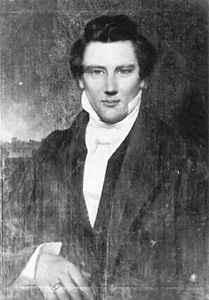
Church History c. 1820-1831, Background, Founding, New York Period |

An early oil painting of the Prophet Joseph Smith (1805-1844). People who knew Joseph Smith personally commented that no picture could do him justice, for when he spoke compassion and power were evident, sometimes to the point that his countenance became visibly radiant. Artist unknown. Courtesy Library-Archives, Reorganized Church of Jesus Christ of Latter Day Saints.
by Richard L. Bushman and Larry C. Porter
The establishment of The Church of Jesus Christ of Latter-day Saints began in the 1820s with events that occurred primarily in New York State. The Prophet Joseph Smith received his first vision in 1820, obtained the gold plates of the Book of Mormon from the hill Cumorah in 1827, received priesthood authority in 1829, and officially organized the Church on April 6, 1830. By the time the Church left New York for Ohio early in 1831, it was organized and its basic direction was clearly established.
In its formative years, the infant Church learned above all to depend on revelation for direction. Joseph Smith, young and relatively unschooled, did not pretend to work out the doctrines of the new Church by himself. Direct revelations from God led him step by step. Perhaps the most revolutionary idea in the Church is its belief in Christian revelation beyond the Bible. Latter-day Saints have never doubted the inspiration of the Bible; it has been an essential standard from the beginning (see Bible: LDS belief in). Their experience led them to realize, however, that God also spoke to prophets who were not included in that conventional canon of scripture: the Book of Mormon showed them this (2 Ne. 29:10-14), and they heard Joseph Smith speak with the same authority as biblical apostles and prophets. Consequently, Latter-day Saints began to think of revelation in a new way, and the principle of continuing revelation greatly disturbed their fellow Christians, but from the beginning nothing was more basic to the Church.
The History of the Church begins with the family of Joseph Smith, Sr., and Lucy Mack Smith, the Prophet's parents (see Smith Family), who, with thousands of other New Englanders, flooded into New York in the early nineteenth century looking for better land. They brought with them their Calvinist religious intensity, but with a zeal modified by the new conditions of life in republican and pluralistic America. They had long searched without success for a faith on which they could rely. The increasing number of Christian denominations and a host of new intellectual influences from the Enlightenment made it more difficult to embrace religious faith than when Congregationalism had predominated in New England. Joseph Smith's quest for salvation began with the question of which Church is true. This question was possibly thrust upon him by his parents' uncertainties and by the plurality of churches—Presbyterian, Baptist, Methodist, Quaker—in his own village.
Moved by evangelical revivals, Joseph Smith asked for direction from God about the true religion in the early spring of 1820. Although only fourteen, he had confidence in the biblical promise that he could get an answer (James 1:5). He went into the woods near his home, kneeled down, and prayed. In his accounts of the event (See His Personal Account of the Events), he testifies that the answer he received astonished him. Both God the Father and Jesus Christ appeared and told him to join none of the existing churches. He was assured that he was in good standing with God, told many things he could not write about, and then the vision closed, leaving him overcome. This revelation of the Father and the Son is considered by Latter-day Saints to be the opening event in the restoration of the gospel.
For three and a half years Joseph received no further communication from the heavens. Wondering if he had disqualified himself through unworthiness, Joseph was praying on the evening of September 21, 1823, when to his astonishment, an angel appeared in the room and announced that he was Moroni and had come with instructions from God. He told Joseph about a record written on gold plates giving a history of the former inhabitants of the western continents. The resurrected Savior, Jesus Christ, had appeared to these people and had given them the fulness of the gospel. The angel said the plates were buried in a hill near Joseph's home. In the course of the night, the angel came three times, delivering the same basic message and adding a little more information each time. Although exhausted, Joseph went to the hill the next day and found the plates encased in a stone box just below the surface of the earth; but he was not allowed to remove them. The angel appeared again and told him he must come back again the following year on the same day, September 22. For the next four years, Joseph faithfully returned to that place in the same manner. Finally, on September 22, 1827, he was allowed to take the plates into his possession (see Moroni, Visitations of).
The events of the four-year interval between 1823 and 1827 doubtless helped Joseph Smith to mature in preparation for the responsibilities and challenges that subsequently came to him. There is some evidence that his father was involved in treasure hunting, a common activity among poor New England farmers who hoped through the use of magic to discover buried money, and it was necessary for Joseph to extricate himself from the mistaken notions of that superstition. The angel told Joseph that one of the reasons for the delay in giving him the gold plates was that he had dwelt on their monetary worth (PWJS, p. 7). In November 1825, Joseph and his father worked briefly with a man named Josiah Stowell of South Bainbridge (afton), New York, who believed a Spanish treasure was located in harmony, pennsylvania, near the Susquehannah River. The project failed, and the Smiths gradually separated themselves from the money-digging activities of their neighbors to concentrate on the religious mission described by the angel. As a happy outgrowth of the Harmony project, while working there Joseph met Emma Hale (see Smith, Emma Hale), whom he married on January 18, 1827. In the meantime, his older brother Alvin died; Joseph was arrested in 1826 as a "glass looker" under a New York law that made it a crime "to tell fortunes, or where lost or stolen goods may be found" (see the legal definition of "Disorderly Persons," The Justice's Manual, Albany, New York, 1829, p. 144; see also Legal Trials of Joseph Smith); and his parents lost their farm through their inability to make the last mortgage payment. These misfortunes, along with other experiences, deepened and strengthened the young man as he learned to discern between good and evil and to endure opposition.
After Joseph obtained the plates in 1827, curious and sometimes malicious neighbors in Manchester and Palmyra, New York, made it impossible to begin work on the translation. They ransacked the Smith house and barn, and only by constantly moving and concealing the plates could he keep them safe. He had been strictly warned not to show them to anyone, but that did not satisfy the curiosity seekers. Emma's brother, Alva, offered to help; he transported the pair with their belongings and the plates—hidden in a barrel of beans—125 miles to Harmony, Pennsylvania, where Emma's father lived. Joseph procured some acreage from his father-in-law, Isaac Hale, and a small house was provided. It was here that the translation began (see Book of Mormon Translation by Joseph Smith).
A sympathetic neighbor from Palmyra, Martin Harris, took enough interest in the plates to visit Joseph in Harmony. With the plates, Joseph had received an instrument called interpreters, or a Urim and Thummim, that enabled him to translate the characters engraved on the metal tablets. Joseph made copies of a few characters for Martin to take to language experts in Albany and New York City to verify Joseph's work. There is some confusion about what happened in these interviews, but Martin Harris was unequivocally satisfied (see Anthon Transcript). When he returned to Harmony, he offered to take the dictation as Joseph translated. Between April 12 and June 14, 1828, the two of them completed 116 pages of manuscript. At this point, Harris, who suffered from his wife's doubts about the existence of the plates, asked permission to show the manuscript to her and four other family members. With great reluctance Joseph Smith agreed. After hearing nothing from Martin for a number of weeks, Joseph went to his parents home in Manchester, New York, to confront him. Martin despairingly confessed that he could not find the manuscript. He had succumbed to pressure, shown the manuscript to neighbors beyond his agreement, and someone had stolen it (see Manuscript, Lost 116 Pages).
On the occasion of the crisis, Joseph received a revelation through the Urim and Thummim in which the Lord severely rebuked him. He more than Martin was held responsible for the loss of the manuscript. "Behold, you should not have feared man more than God," he was told (D&C 3:7). Martin did no more transcribing for Joseph, and from that time until the spring of 1829, Joseph accomplished little on the translation. In April, Oliver Cowdery, a young schoolteacher who had boarded with the Smith family in Manchester, came to learn more about the Book of Mormon. Having himself received a vision of the Lord and the plates, he was persuaded that the work was divine and offered to serve as scribe (PWJS, p. 8). Beginning on April 7, 1829, the two, Joseph and Oliver, worked together almost constantly until the translation was completed in June, a little more than two months later.
In the course of translating a portion of 3 Nephi that described the manner of baptism, Joseph and Oliver wondered about their own need for baptism. As had become customary with Joseph, he sought instruction from God. On May 15, 1829, while he and Oliver prayed, a heavenly messenger appeared to them. Identifying himself as John the Baptist, he conferred on them the Aaronic Priesthood, which gave them the authority to baptize (see Aaronic Priesthood: Restoration). With that newly received authority and under the direction of the angel, the two men baptized each other in the Susquehannah River. This revelation established an important principle in the Church: that divine ordinances such as baptism can be performed only by persons who have received priesthood authority by ordination. John the Baptist told Joseph and Oliver they would later receive a second and higher priesthood called the Melchizedek Priesthood. Subsequently Peter, James, and John appeared to them on the banks of the Susquehannah River some place between Harmony and Colesville, New York, and ordained them apostles (see Melchizedek Priesthood Restoration).
By late May 1829, religious opposition against Joseph was growing in Harmony, and he and Oliver needed a calmer place to work. Oliver wrote to a friend, David Whitmer, who agreed to move them to his family's farm in Fayette, New York. Emma joined them in Fayette shortly afterward. A copyright was obtained for the Book of Mormon on June 11, 1829, and the translation soon was completed. As they completed the book, Joseph Smith learned through revelation that others would be allowed to see the golden plates. Witnesses were promised in the Book of Mormon itself, and Joseph's associates were eager to know who would have the privilege. Martin Harris, David Whitmer, and Oliver Cowdery were chosen, shown the plates by the angel Moroni, and heard the voice of God declaring to them that the work had been translated by the power of God. A few days later at Manchester, Joseph Smith was permitted to show the plates to eight other men. They examined the plates closely and lifted them with their hands. The statements of these two sets of witnesses were printed in the back pages of the 1830 edition of the Book of Mormon and appear in the front pages of all recent editions (see Book of Mormon Witnesses).
Finding a printer to publish the Book of Mormon proved to be difficult. Palmyra people who were suspicious of Joseph Smith banded together to intimidate the local printer, Egbert B. Grandin, by threatening not to purchase copies. Others, like Martin's wife, Lucy Harris, challenged Joseph's financial motives. After contacting printers as far away as Rochester, Joseph persuaded Grandin to accept the job. Martin Harris's guarantee made the difference in Grandin's decision. On August 25, 1829, Harris mortgaged his farm, pledging to pay $3,000 for 5,000 copies. Joseph and Martin hoped to sell enough copies to raise at least $3,000, but in the end Martin had to sell 151 acres to fulfill his agreement. Typesetting began in August 1829, and finished copies were available March 26, 1830.
Publication of the Book of Mormon brought to a close the endeavor that had occupied Joseph Smith since receiving the plates in 1827. Meanwhile, the revelations he was receiving made clear that translating the Book of Mormon was not the end of his divine mission. He was also to organize a church. Samuel Smith had been baptized in Harmony in late May 1829; Hyrum Smith, David and Peter Whitmer, Jr., and others were baptized in June in Seneca Lake. They had begun meeting together, and they had taught and tried to persuade all who requested information. On April 6, 1830, in the house of Peter Whitmer, Sr., in Fayette, New York, Joseph Smith organized the Church of Jesus Christ (see Organization of the Church, 1830: Name of the Church). Six men subscribed as members, and over fifty people were present. The group sustained two officers as leaders of the Church, Joseph Smith as first elder and Oliver Cowdery as second elder. Joseph was also given the titles of seer, translator, and prophet. In addition, a revelation made provision for ordaining elders, priests, teachers, and deacons as a lay priesthood (see Doctrine and Covenants: Sections 20-22). Some of the lay persons present at the organization were ordained that day, and from the start, the Church made no provision for a special clerical order (see Lay Participation and Leadership).
Three clusters of believers were organized into branches of the fledgling Church soon after its organization—one in Fayette; another in Manchester at the old Smith home; and a third in colesville in southern New York, which was near the farm of Josiah Stowell (in Bainbridge Township, Chenango County), Joseph's one time employer and a loyal supporter. Members of the Joseph Knight family, who had provided Joseph and his assistants food and clothing during the translation, lived in Colesville and were the nucleus of the branch there. Joseph and Emma moved back to their house in Harmony, but met with all three branches at prescribed quarterly conferences held at the Peter Whitmer farm in June and September 1830.
In the summer of 1830, troubles began to arise. Twice Joseph was put on trial as a "disorderly person." Both times he was acquitted. More disturbing to Joseph, some of his own followers questioned his authority and claimed revelations and prerogatives of their own. Hiram Page, ordained a teacher in June 1830 and a husband of Catherine Whitmer, wrote out a sheaf of revelations he claimed came from God. Although still young and inexperienced, Joseph sensed the confusion and danger of many voices trying to speak authoritatively. At the September conference in Fayette, Joseph received a revelation that established that only one person approved by common consent was to receive commandments and revelations for the entire Church (D&C 20:65; 28:1-3, 11-13). Hiram Page lacked that authorization. After hearing Joseph, the conference confirmed him as sole revelator for the Church (D&C 28:2; D. Cannon and L. Cook, eds., Far West Record, Salt Lake City, 1983, p. 3). This principle of revelation for the whole Church coming through the man sustained as the Prophet remains a practice of the Church to this day.
In the six months after the organization of the Church, converts were added in small numbers. Joseph Smith's brother Samuel went out with copies of the Book of Mormon to share with anyone interested. Joseph Smith, Sr., visited his brothers, sisters, and parents in St. Lawrence County, New York, where most of them lived, to tell them what had happened. Later conversions resulted from these expeditions, but very few at the time. Parley P. Pratt, a farmer from Ohio, believed that God led him to the house of Hyrum Smith, Joseph's brother, to find out about the Book of Mormon.
The most successful early missionary venture was launched in September and October 1830, when Oliver Cowdery, Peter Whitmer, Jr., Parley Pratt, and Ziba Peterson were called to teach the Indians (see Lamanite Mission). The Book of Mormon had special relevance for Native Americans because it was a religious record from ancient America, and the four were charged to take this message to the Indians who were assembling in the territory west of Missouri. The mission was notable as much for what was accomplished en route, however, as for the preaching to the Indians. After leaving New York, the missionaries stopped in the Mentor-Kirtland area of northeast Ohio near Pratt's former farm. Before joining the Church, Pratt had been associated with the Campbellite movement, which was forming into the Disciples of Christ church. This group believed in rigorously adhering to the teachings and practices of the New Testament church, sloughing off all later additions. The teachings of Joseph Smith appealed to many of them because his doctrines embodied for them a pure restoration of true Christianity. About 130 persons were converted, including the leading Campbellite preacher in the area, Sidney Rigdon. In a few weeks, the four missionaries nearly doubled the membership of the Church. They continued on to Indian country that winter, enduring severe hardships on their long trek on foot from St. Louis across Missouri. They found a land in western Missouri into which the Church would soon begin settling. They also taught among the Delaware and Shawnee Indians until government officials told them to stop because of a prohibition against proselytizing among the tribes.
Soon after the missionaries left Ohio for the West in December 1830, Sidney Rigdon left for New York, accompanied by Edward Partridge. They brought news of the conversions in Ohio and urged Joseph Smith and the membership to move there. Joseph was prepared to take the suggestion seriously because of revelations he received concerning the gathering of the Church (D&C 37:1-4; 38:31-33). Indeed, for the remainder of the century, converts to the Church would assemble at a central gathering place, first in Ohio, then in Missouri, in Illinois, and finally in Utah. Another revelation focused on the second coming of Jesus Christ and on the destructions to be visited upon the world before that event occurred. It said that before those tribulations, the people of God were to "be gathered in unto one place upon the face of this land" (D&C 29:8). A further revelation spoke of a city of Zion to be built somewhere in the West (D&C 28:9). These hints led Church members to realize that they would not remain long in New York.
When a revelation came in December 1830 (D&C 37) telling them to move to Ohio, it was accepted by most. At a conference on January 2, 1831, directions and an additional revelation (D&C 38) were given for the move. The Prophet, Emma, and a few others went ahead and arrived in Kirtland on February 1, 1831, to prepare for the arrival of others. The Colesville Branch, under Newel Knight; the Fayette Branch, under the Prophet's mother and Thomas Marsh; and the Manchester Branch, under Martin Harris, traveled to Ohio in separate companies during April and May 1831. By mid-May virtually all of the New York Mormons from the named branches were in Kirtland.
(See Daily Living home page; Church History home page; 1820-1831 home page)
Illustrations
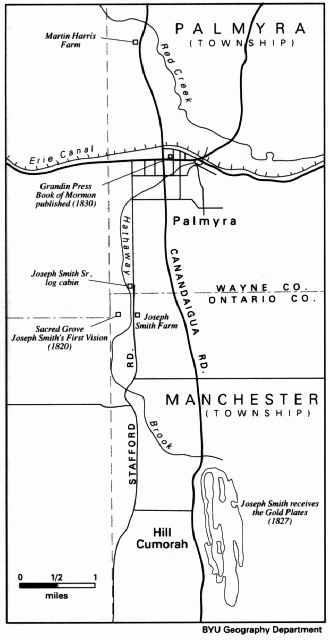
Church history sites near Palmyra, N.Y., 1820-1831.
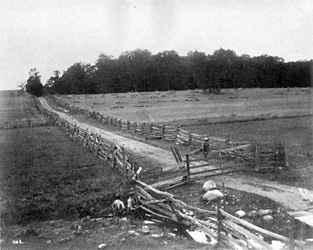
Path leading from the Smith home to an area known as the Sacred Grove, south of Palmyra, New York. Photographed c. 1907. Photographer: George E. Anderson. Courtesy Nelson Wadsworth.
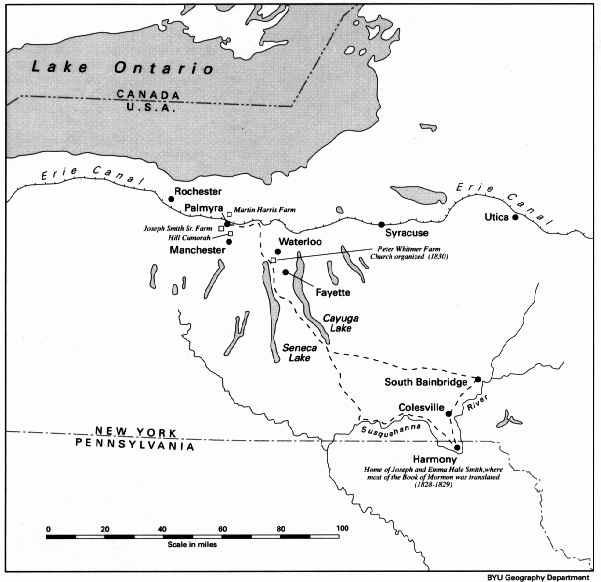
Church history sites in western New York, 1820-1831.
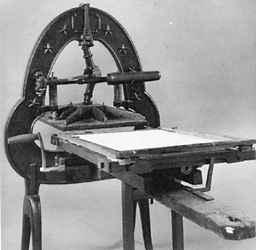
E. B. Grandin Press, on which pages of the first edition of the Book of Mormon were printed, August 1829 to March 1830, in Palmyra, New York.
Bibliography
Backman, Milton V., Jr. Eyewitness Accounts of the Restoration, rev. ed. Salt Lake City, 1986.
Bushman, Richard L. Joseph Smith and the Beginnings of Mormonism. Urbana, Ill., 1984.
Madsen, Truman, G., guest ed. BYU Studies 9 (Spring 1969):235-404 (entire issue devoted to LDS origins in New York).
Porter, Larry C. "A Study of the Origins of The Church of Jesus Christ of Latter-day Saints in the States of New York and Pennsylvania, 1816-1831." Ph.D. diss., Brigham Young University, 1971.
Smith, Lucy Mack. History of Joseph Smith, ed. Preston Nibley. Salt Lake City, 1958.
Whittaker, David J. "Sources on Mormon Origins in New York and Pennsylvania." Mormon History Association Newsletter no. 43 (Mar. 1980):8-12.
Encyclopedia of Mormonism, Vol. 2, History of the Church
Copyright © 1992 by Macmillan Publishing Company
All About Mormons |